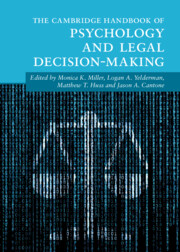Book contents
- The Cambridge Handbook of Psychology and Legal Decision-Making
- Cambridge Handbooks in Psychology
- The Cambridge Handbook of Psychology and Legal Decision-Making
- Copyright page
- Dedication
- Contents
- Figures
- Tables
- Editors
- Contributors
- Part I Introduction Chapters
- Part II Pretrial Phase Decision-Making
- Part III Trial Phase Decision-Making
- Part IV Postconviction Phase Decisions
- 28 Amenability to Treatment Evaluations
- 29 Choosing Between Life and Death
- 30 The Communication of Risk to Legal Decision-Makers
- 31 The Psychology of Parole Decision-Making
- 32 Probation Decision-Making
- 33 Decision-Making in Violence Risk Assessment
- Part V Other Legal Decision-Making
- Part VI Perspectives from the Field
- Part VII Conclusion
- Index
- References
33 - Decision-Making in Violence Risk Assessment
from Part IV - Postconviction Phase Decisions
Published online by Cambridge University Press: 22 February 2024
- The Cambridge Handbook of Psychology and Legal Decision-Making
- Cambridge Handbooks in Psychology
- The Cambridge Handbook of Psychology and Legal Decision-Making
- Copyright page
- Dedication
- Contents
- Figures
- Tables
- Editors
- Contributors
- Part I Introduction Chapters
- Part II Pretrial Phase Decision-Making
- Part III Trial Phase Decision-Making
- Part IV Postconviction Phase Decisions
- 28 Amenability to Treatment Evaluations
- 29 Choosing Between Life and Death
- 30 The Communication of Risk to Legal Decision-Makers
- 31 The Psychology of Parole Decision-Making
- 32 Probation Decision-Making
- 33 Decision-Making in Violence Risk Assessment
- Part V Other Legal Decision-Making
- Part VI Perspectives from the Field
- Part VII Conclusion
- Index
- References
Summary
The literature on violence risk assessment has primarily focused on prescriptive approaches, whereby methods are designed to assess risk to arrive at accurate conceptualizations and decisions regarding future risk. However, we have often failed to think about the underlying decision-making process clinicians exhibit, and especially the decision-making within the limitations of their clinical contexts. Understanding this underlying decision-making process is imperative to maximize the success or accuracy of our prescriptive approaches. The current chapter seeks to review the history of decision-making across the generations of violence risk assessment and identify our primary approaches to risk assessment decision-making, or our prescriptive approaches. We then turn our attention toward the decision-making process itself and focus on the information we use to arrive at our decisions regarding violence risk and the use of this information in clinical practice. Finally, we identify areas of future exploration.
- Type
- Chapter
- Information
- The Cambridge Handbook of Psychology and Legal Decision-Making , pp. 510 - 522Publisher: Cambridge University PressPrint publication year: 2024

